Financial Performance and Business Environment of Tesco Plc: A Study
VerifiedAdded on 2020/06/04
|31
|8380
|97
Report
AI Summary
This report provides a comprehensive analysis of Tesco Plc's financial performance, business environment, and Corporate Social Responsibility (CSR) initiatives. The study employs a mixed research approach, utilizing secondary data from Tesco's annual reports, books, journals, and scholarly articles. The analysis includes ratio analysis, horizontal analysis, and business analysis (SWOT and PESTEL) to assess Tesco's financial position and its standing within the UK retail environment. The report evaluates profitability, liquidity, solvency, and efficiency ratios to gauge Tesco's financial health. Furthermore, it examines Tesco's CSR policies and their impact on the company's brand image and market share. The findings suggest that while the political and economic conditions in the UK retail sector are favorable, Tesco needs to focus on technological advancements and environmental sustainability to maintain its competitive edge. The report concludes with recommendations for Tesco to improve its financial performance and enhance its CSR efforts.

1
Paraphrase This Document
Need a fresh take? Get an instant paraphrase of this document with our AI Paraphraser
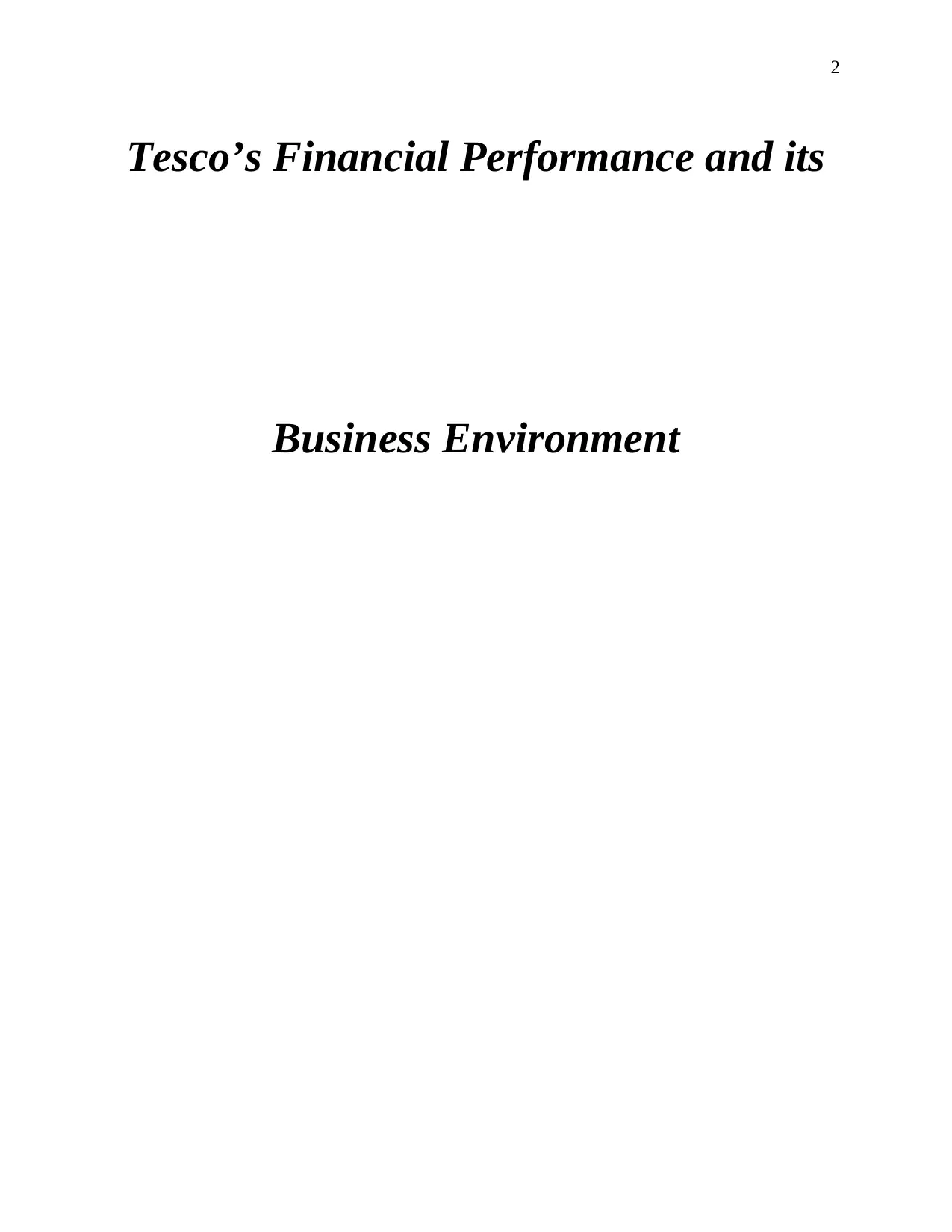
Tesco’s Financial Performance and its
Business Environment
2
Business Environment
2
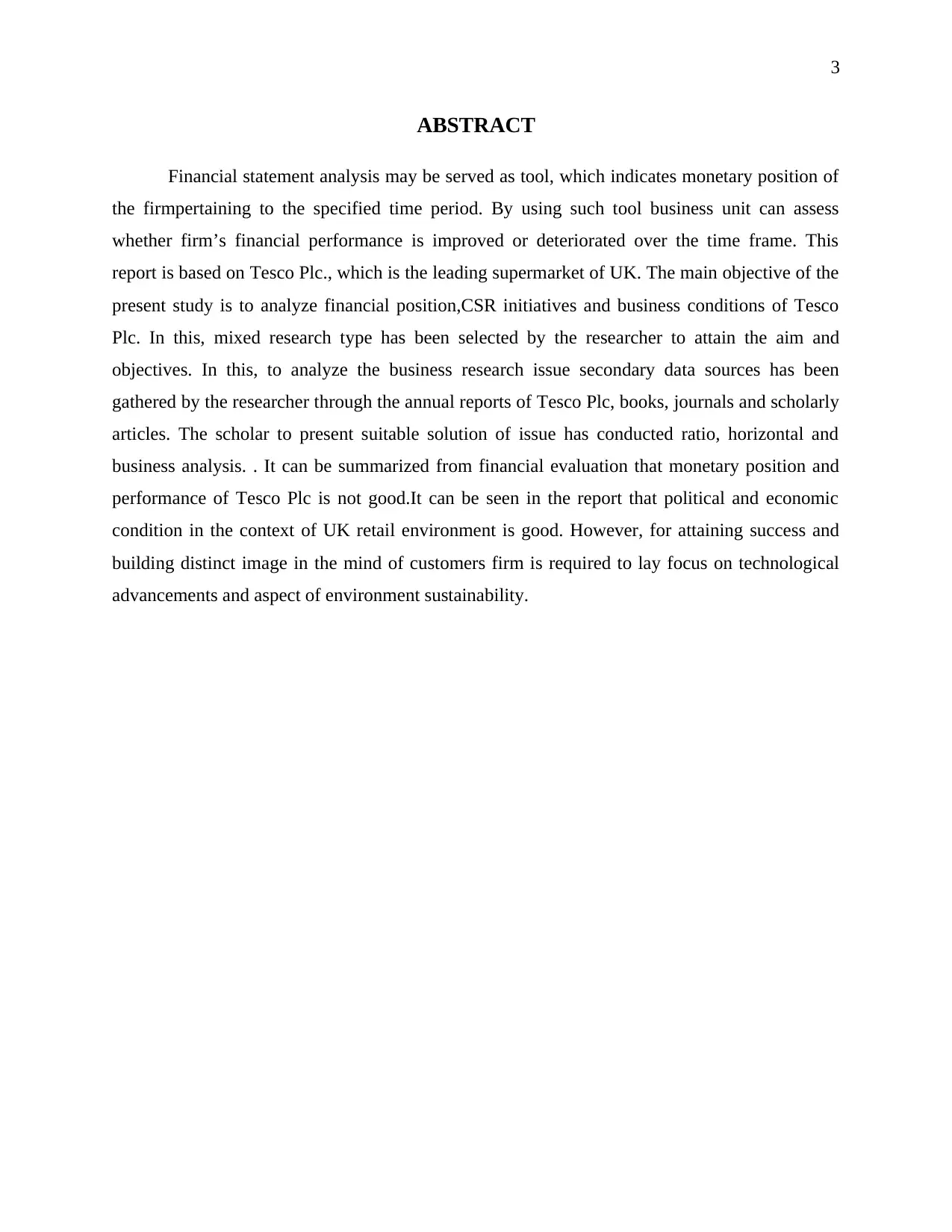
ABSTRACT
Financial statement analysis may be served as tool, which indicates monetary position of
the firmpertaining to the specified time period. By using such tool business unit can assess
whether firm’s financial performance is improved or deteriorated over the time frame. This
report is based on Tesco Plc., which is the leading supermarket of UK. The main objective of the
present study is to analyze financial position,CSR initiatives and business conditions of Tesco
Plc. In this, mixed research type has been selected by the researcher to attain the aim and
objectives. In this, to analyze the business research issue secondary data sources has been
gathered by the researcher through the annual reports of Tesco Plc, books, journals and scholarly
articles. The scholar to present suitable solution of issue has conducted ratio, horizontal and
business analysis. . It can be summarized from financial evaluation that monetary position and
performance of Tesco Plc is not good.It can be seen in the report that political and economic
condition in the context of UK retail environment is good. However, for attaining success and
building distinct image in the mind of customers firm is required to lay focus on technological
advancements and aspect of environment sustainability.
3
Financial statement analysis may be served as tool, which indicates monetary position of
the firmpertaining to the specified time period. By using such tool business unit can assess
whether firm’s financial performance is improved or deteriorated over the time frame. This
report is based on Tesco Plc., which is the leading supermarket of UK. The main objective of the
present study is to analyze financial position,CSR initiatives and business conditions of Tesco
Plc. In this, mixed research type has been selected by the researcher to attain the aim and
objectives. In this, to analyze the business research issue secondary data sources has been
gathered by the researcher through the annual reports of Tesco Plc, books, journals and scholarly
articles. The scholar to present suitable solution of issue has conducted ratio, horizontal and
business analysis. . It can be summarized from financial evaluation that monetary position and
performance of Tesco Plc is not good.It can be seen in the report that political and economic
condition in the context of UK retail environment is good. However, for attaining success and
building distinct image in the mind of customers firm is required to lay focus on technological
advancements and aspect of environment sustainability.
3
⊘ This is a preview!⊘
Do you want full access?
Subscribe today to unlock all pages.

Trusted by 1+ million students worldwide
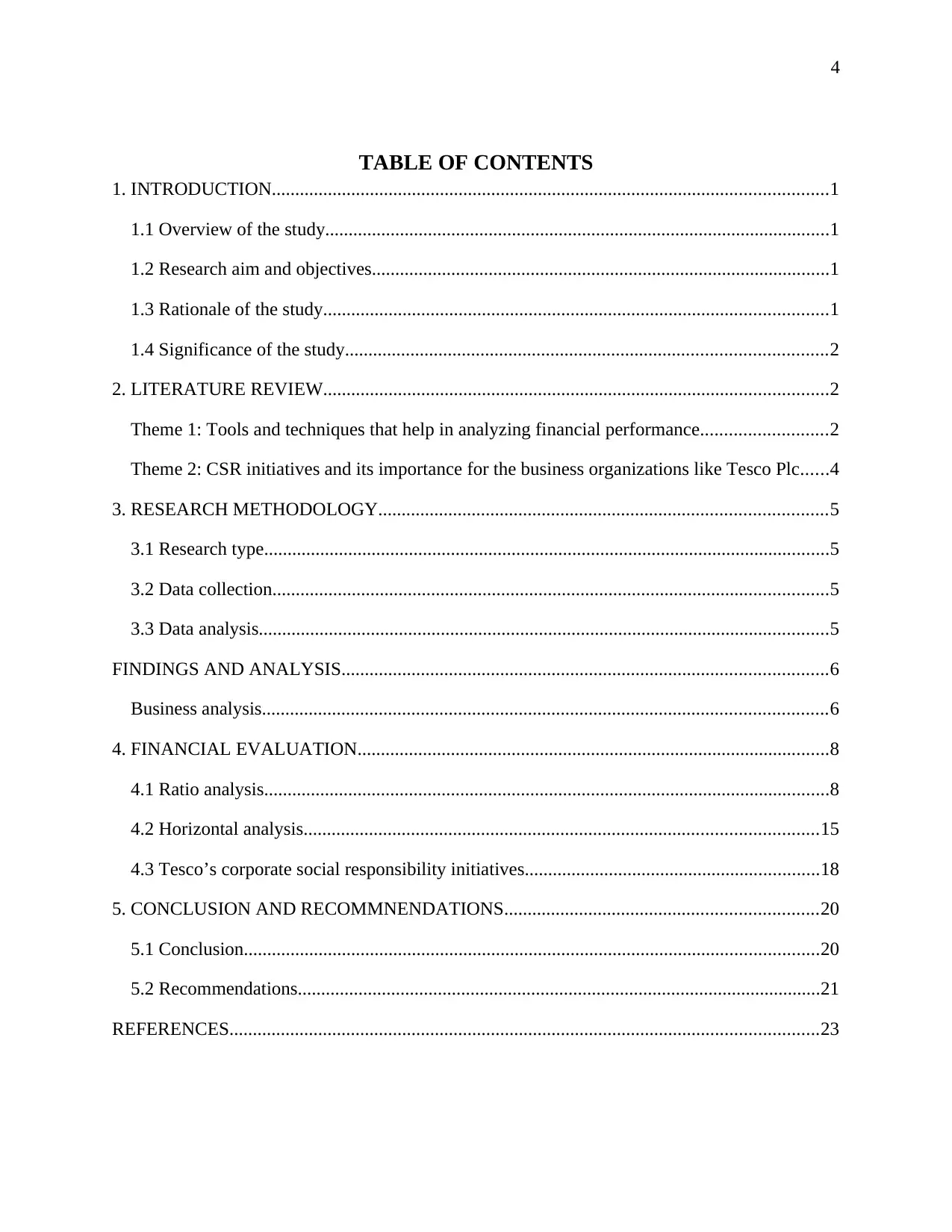
TABLE OF CONTENTS
1. INTRODUCTION.......................................................................................................................1
1.1 Overview of the study............................................................................................................1
1.2 Research aim and objectives..................................................................................................1
1.3 Rationale of the study............................................................................................................1
1.4 Significance of the study.......................................................................................................2
2. LITERATURE REVIEW............................................................................................................2
Theme 1: Tools and techniques that help in analyzing financial performance...........................2
Theme 2: CSR initiatives and its importance for the business organizations like Tesco Plc......4
3. RESEARCH METHODOLOGY................................................................................................5
3.1 Research type.........................................................................................................................5
3.2 Data collection.......................................................................................................................5
3.3 Data analysis..........................................................................................................................5
FINDINGS AND ANALYSIS........................................................................................................6
Business analysis.........................................................................................................................6
4. FINANCIAL EVALUATION.....................................................................................................8
4.1 Ratio analysis.........................................................................................................................8
4.2 Horizontal analysis..............................................................................................................15
4.3 Tesco’s corporate social responsibility initiatives...............................................................18
5. CONCLUSION AND RECOMMNENDATIONS...................................................................20
5.1 Conclusion...........................................................................................................................20
5.2 Recommendations................................................................................................................21
REFERENCES..............................................................................................................................23
4
1. INTRODUCTION.......................................................................................................................1
1.1 Overview of the study............................................................................................................1
1.2 Research aim and objectives..................................................................................................1
1.3 Rationale of the study............................................................................................................1
1.4 Significance of the study.......................................................................................................2
2. LITERATURE REVIEW............................................................................................................2
Theme 1: Tools and techniques that help in analyzing financial performance...........................2
Theme 2: CSR initiatives and its importance for the business organizations like Tesco Plc......4
3. RESEARCH METHODOLOGY................................................................................................5
3.1 Research type.........................................................................................................................5
3.2 Data collection.......................................................................................................................5
3.3 Data analysis..........................................................................................................................5
FINDINGS AND ANALYSIS........................................................................................................6
Business analysis.........................................................................................................................6
4. FINANCIAL EVALUATION.....................................................................................................8
4.1 Ratio analysis.........................................................................................................................8
4.2 Horizontal analysis..............................................................................................................15
4.3 Tesco’s corporate social responsibility initiatives...............................................................18
5. CONCLUSION AND RECOMMNENDATIONS...................................................................20
5.1 Conclusion...........................................................................................................................20
5.2 Recommendations................................................................................................................21
REFERENCES..............................................................................................................................23
4
Paraphrase This Document
Need a fresh take? Get an instant paraphrase of this document with our AI Paraphraser

5
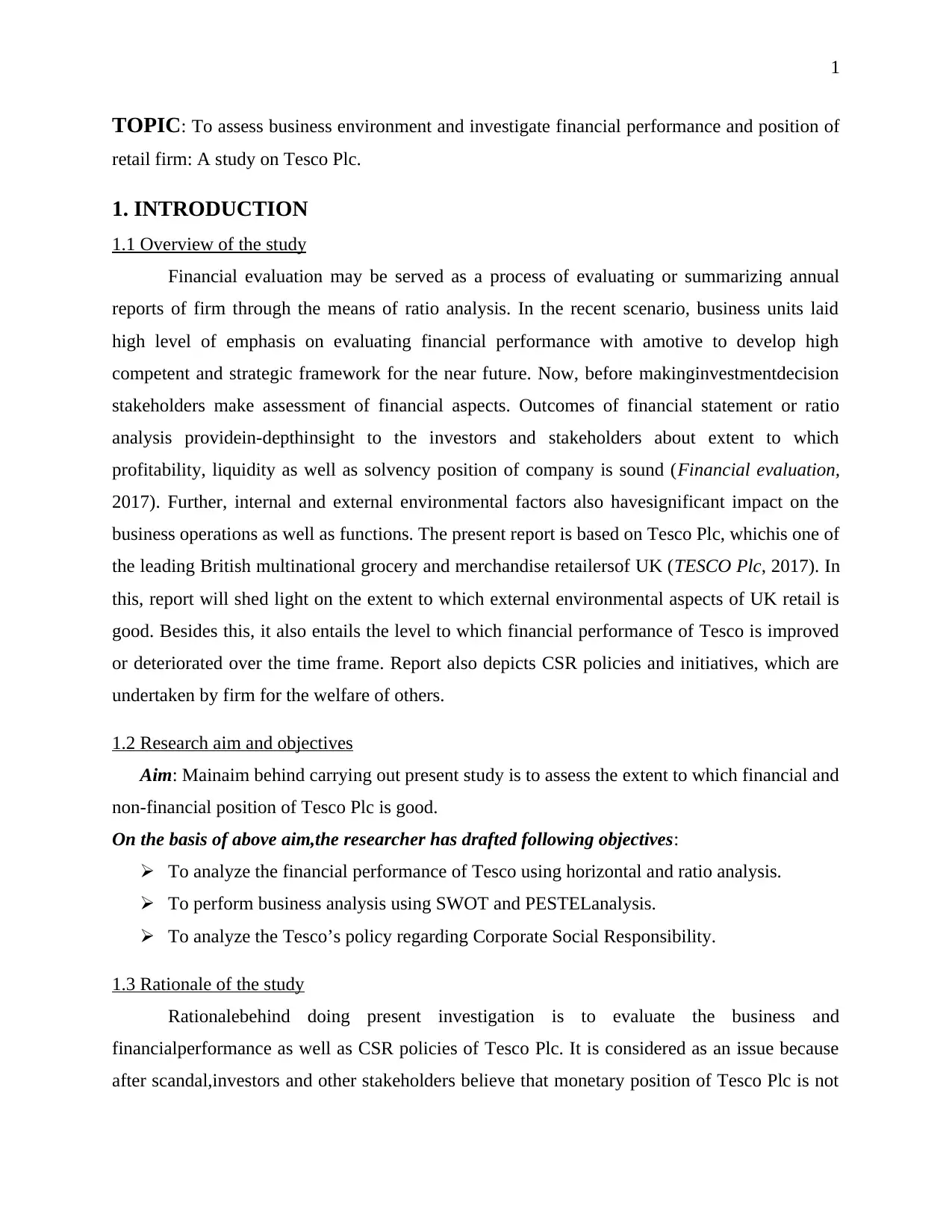
TOPIC: To assess business environment and investigate financial performance and position of
retail firm: A study on Tesco Plc.
1. INTRODUCTION
1.1 Overview of the study
Financial evaluation may be served as a process of evaluating or summarizing annual
reports of firm through the means of ratio analysis. In the recent scenario, business units laid
high level of emphasis on evaluating financial performance with amotive to develop high
competent and strategic framework for the near future. Now, before makinginvestmentdecision
stakeholders make assessment of financial aspects. Outcomes of financial statement or ratio
analysis providein-depthinsight to the investors and stakeholders about extent to which
profitability, liquidity as well as solvency position of company is sound (Financial evaluation,
2017). Further, internal and external environmental factors also havesignificant impact on the
business operations as well as functions. The present report is based on Tesco Plc, whichis one of
the leading British multinational grocery and merchandise retailersof UK (TESCO Plc, 2017). In
this, report will shed light on the extent to which external environmental aspects of UK retail is
good. Besides this, it also entails the level to which financial performance of Tesco is improved
or deteriorated over the time frame. Report also depicts CSR policies and initiatives, which are
undertaken by firm for the welfare of others.
1.2 Research aim and objectives
Aim: Mainaim behind carrying out present study is to assess the extent to which financial and
non-financial position of Tesco Plc is good.
On the basis of above aim,the researcher has drafted following objectives:
To analyze the financial performance of Tesco using horizontal and ratio analysis.
To perform business analysis using SWOT and PESTELanalysis.
To analyze the Tesco’s policy regarding Corporate Social Responsibility.
1.3 Rationale of the study
Rationalebehind doing present investigation is to evaluate the business and
financialperformance as well as CSR policies of Tesco Plc. It is considered as an issue because
after scandal,investors and other stakeholders believe that monetary position of Tesco Plc is not
1
retail firm: A study on Tesco Plc.
1. INTRODUCTION
1.1 Overview of the study
Financial evaluation may be served as a process of evaluating or summarizing annual
reports of firm through the means of ratio analysis. In the recent scenario, business units laid
high level of emphasis on evaluating financial performance with amotive to develop high
competent and strategic framework for the near future. Now, before makinginvestmentdecision
stakeholders make assessment of financial aspects. Outcomes of financial statement or ratio
analysis providein-depthinsight to the investors and stakeholders about extent to which
profitability, liquidity as well as solvency position of company is sound (Financial evaluation,
2017). Further, internal and external environmental factors also havesignificant impact on the
business operations as well as functions. The present report is based on Tesco Plc, whichis one of
the leading British multinational grocery and merchandise retailersof UK (TESCO Plc, 2017). In
this, report will shed light on the extent to which external environmental aspects of UK retail is
good. Besides this, it also entails the level to which financial performance of Tesco is improved
or deteriorated over the time frame. Report also depicts CSR policies and initiatives, which are
undertaken by firm for the welfare of others.
1.2 Research aim and objectives
Aim: Mainaim behind carrying out present study is to assess the extent to which financial and
non-financial position of Tesco Plc is good.
On the basis of above aim,the researcher has drafted following objectives:
To analyze the financial performance of Tesco using horizontal and ratio analysis.
To perform business analysis using SWOT and PESTELanalysis.
To analyze the Tesco’s policy regarding Corporate Social Responsibility.
1.3 Rationale of the study
Rationalebehind doing present investigation is to evaluate the business and
financialperformance as well as CSR policies of Tesco Plc. It is considered as an issue because
after scandal,investors and other stakeholders believe that monetary position of Tesco Plc is not
1
⊘ This is a preview!⊘
Do you want full access?
Subscribe today to unlock all pages.

Trusted by 1+ million students worldwide
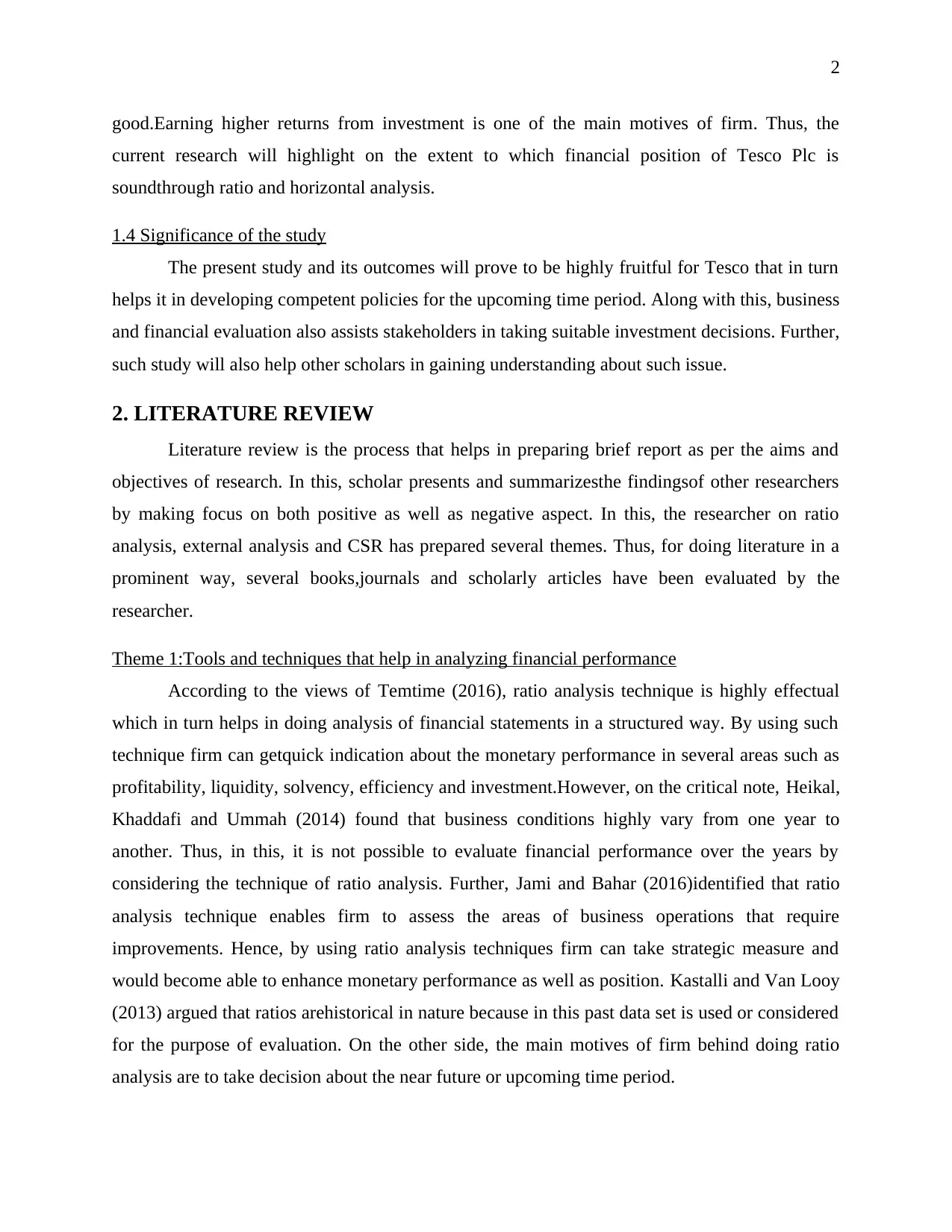
good.Earning higher returns from investment is one of the main motives of firm. Thus, the
current research will highlight on the extent to which financial position of Tesco Plc is
soundthrough ratio and horizontal analysis.
1.4 Significance of the study
The present study and its outcomes will prove to be highly fruitful for Tesco that in turn
helps it in developing competent policies for the upcoming time period. Along with this, business
and financial evaluation also assists stakeholders in taking suitable investment decisions. Further,
such study will also help other scholars in gaining understanding about such issue.
2. LITERATURE REVIEW
Literature review is the process that helps in preparing brief report as per the aims and
objectives of research. In this, scholar presents and summarizesthe findingsof other researchers
by making focus on both positive as well as negative aspect. In this, the researcher on ratio
analysis, external analysis and CSR has prepared several themes. Thus, for doing literature in a
prominent way, several books,journals and scholarly articles have been evaluated by the
researcher.
Theme 1:Tools and techniques that help in analyzing financial performance
According to the views of Temtime (2016), ratio analysis technique is highly effectual
which in turn helps in doing analysis of financial statements in a structured way. By using such
technique firm can getquick indication about the monetary performance in several areas such as
profitability, liquidity, solvency, efficiency and investment.However, on the critical note, Heikal,
Khaddafi and Ummah (2014) found that business conditions highly vary from one year to
another. Thus, in this, it is not possible to evaluate financial performance over the years by
considering the technique of ratio analysis. Further, Jami and Bahar (2016)identified that ratio
analysis technique enables firm to assess the areas of business operations that require
improvements. Hence, by using ratio analysis techniques firm can take strategic measure and
would become able to enhance monetary performance as well as position. Kastalli and Van Looy
(2013) argued that ratios arehistorical in nature because in this past data set is used or considered
for the purpose of evaluation. On the other side, the main motives of firm behind doing ratio
analysis are to take decision about the near future or upcoming time period.
2
current research will highlight on the extent to which financial position of Tesco Plc is
soundthrough ratio and horizontal analysis.
1.4 Significance of the study
The present study and its outcomes will prove to be highly fruitful for Tesco that in turn
helps it in developing competent policies for the upcoming time period. Along with this, business
and financial evaluation also assists stakeholders in taking suitable investment decisions. Further,
such study will also help other scholars in gaining understanding about such issue.
2. LITERATURE REVIEW
Literature review is the process that helps in preparing brief report as per the aims and
objectives of research. In this, scholar presents and summarizesthe findingsof other researchers
by making focus on both positive as well as negative aspect. In this, the researcher on ratio
analysis, external analysis and CSR has prepared several themes. Thus, for doing literature in a
prominent way, several books,journals and scholarly articles have been evaluated by the
researcher.
Theme 1:Tools and techniques that help in analyzing financial performance
According to the views of Temtime (2016), ratio analysis technique is highly effectual
which in turn helps in doing analysis of financial statements in a structured way. By using such
technique firm can getquick indication about the monetary performance in several areas such as
profitability, liquidity, solvency, efficiency and investment.However, on the critical note, Heikal,
Khaddafi and Ummah (2014) found that business conditions highly vary from one year to
another. Thus, in this, it is not possible to evaluate financial performance over the years by
considering the technique of ratio analysis. Further, Jami and Bahar (2016)identified that ratio
analysis technique enables firm to assess the areas of business operations that require
improvements. Hence, by using ratio analysis techniques firm can take strategic measure and
would become able to enhance monetary performance as well as position. Kastalli and Van Looy
(2013) argued that ratios arehistorical in nature because in this past data set is used or considered
for the purpose of evaluation. On the other side, the main motives of firm behind doing ratio
analysis are to take decision about the near future or upcoming time period.
2
Paraphrase This Document
Need a fresh take? Get an instant paraphrase of this document with our AI Paraphraser
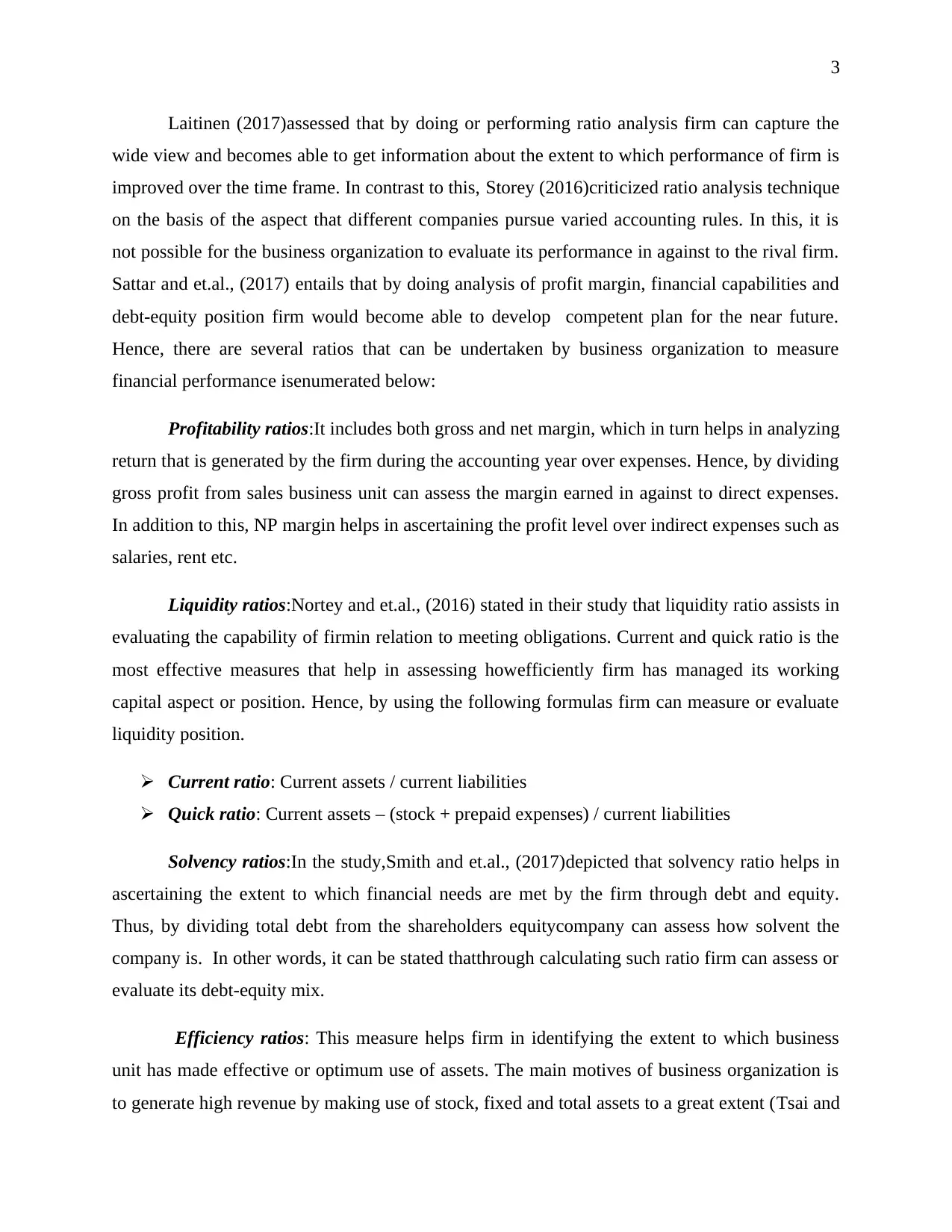
Laitinen (2017)assessed that by doing or performing ratio analysis firm can capture the
wide view and becomes able to get information about the extent to which performance of firm is
improved over the time frame. In contrast to this, Storey (2016)criticized ratio analysis technique
on the basis of the aspect that different companies pursue varied accounting rules. In this, it is
not possible for the business organization to evaluate its performance in against to the rival firm.
Sattar and et.al., (2017) entails that by doing analysis of profit margin, financial capabilities and
debt-equity position firm would become able to develop competent plan for the near future.
Hence, there are several ratios that can be undertaken by business organization to measure
financial performance isenumerated below:
Profitability ratios:It includes both gross and net margin, which in turn helps in analyzing
return that is generated by the firm during the accounting year over expenses. Hence, by dividing
gross profit from sales business unit can assess the margin earned in against to direct expenses.
In addition to this, NP margin helps in ascertaining the profit level over indirect expenses such as
salaries, rent etc.
Liquidity ratios:Nortey and et.al., (2016) stated in their study that liquidity ratio assists in
evaluating the capability of firmin relation to meeting obligations. Current and quick ratio is the
most effective measures that help in assessing howefficiently firm has managed its working
capital aspect or position. Hence, by using the following formulas firm can measure or evaluate
liquidity position.
Current ratio: Current assets / current liabilities
Quick ratio: Current assets – (stock + prepaid expenses) / current liabilities
Solvency ratios:In the study,Smith and et.al., (2017)depicted that solvency ratio helps in
ascertaining the extent to which financial needs are met by the firm through debt and equity.
Thus, by dividing total debt from the shareholders equitycompany can assess how solvent the
company is. In other words, it can be stated thatthrough calculating such ratio firm can assess or
evaluate its debt-equity mix.
Efficiency ratios: This measure helps firm in identifying the extent to which business
unit has made effective or optimum use of assets. The main motives of business organization is
to generate high revenue by making use of stock, fixed and total assets to a great extent (Tsai and
3
wide view and becomes able to get information about the extent to which performance of firm is
improved over the time frame. In contrast to this, Storey (2016)criticized ratio analysis technique
on the basis of the aspect that different companies pursue varied accounting rules. In this, it is
not possible for the business organization to evaluate its performance in against to the rival firm.
Sattar and et.al., (2017) entails that by doing analysis of profit margin, financial capabilities and
debt-equity position firm would become able to develop competent plan for the near future.
Hence, there are several ratios that can be undertaken by business organization to measure
financial performance isenumerated below:
Profitability ratios:It includes both gross and net margin, which in turn helps in analyzing
return that is generated by the firm during the accounting year over expenses. Hence, by dividing
gross profit from sales business unit can assess the margin earned in against to direct expenses.
In addition to this, NP margin helps in ascertaining the profit level over indirect expenses such as
salaries, rent etc.
Liquidity ratios:Nortey and et.al., (2016) stated in their study that liquidity ratio assists in
evaluating the capability of firmin relation to meeting obligations. Current and quick ratio is the
most effective measures that help in assessing howefficiently firm has managed its working
capital aspect or position. Hence, by using the following formulas firm can measure or evaluate
liquidity position.
Current ratio: Current assets / current liabilities
Quick ratio: Current assets – (stock + prepaid expenses) / current liabilities
Solvency ratios:In the study,Smith and et.al., (2017)depicted that solvency ratio helps in
ascertaining the extent to which financial needs are met by the firm through debt and equity.
Thus, by dividing total debt from the shareholders equitycompany can assess how solvent the
company is. In other words, it can be stated thatthrough calculating such ratio firm can assess or
evaluate its debt-equity mix.
Efficiency ratios: This measure helps firm in identifying the extent to which business
unit has made effective or optimum use of assets. The main motives of business organization is
to generate high revenue by making use of stock, fixed and total assets to a great extent (Tsai and
3
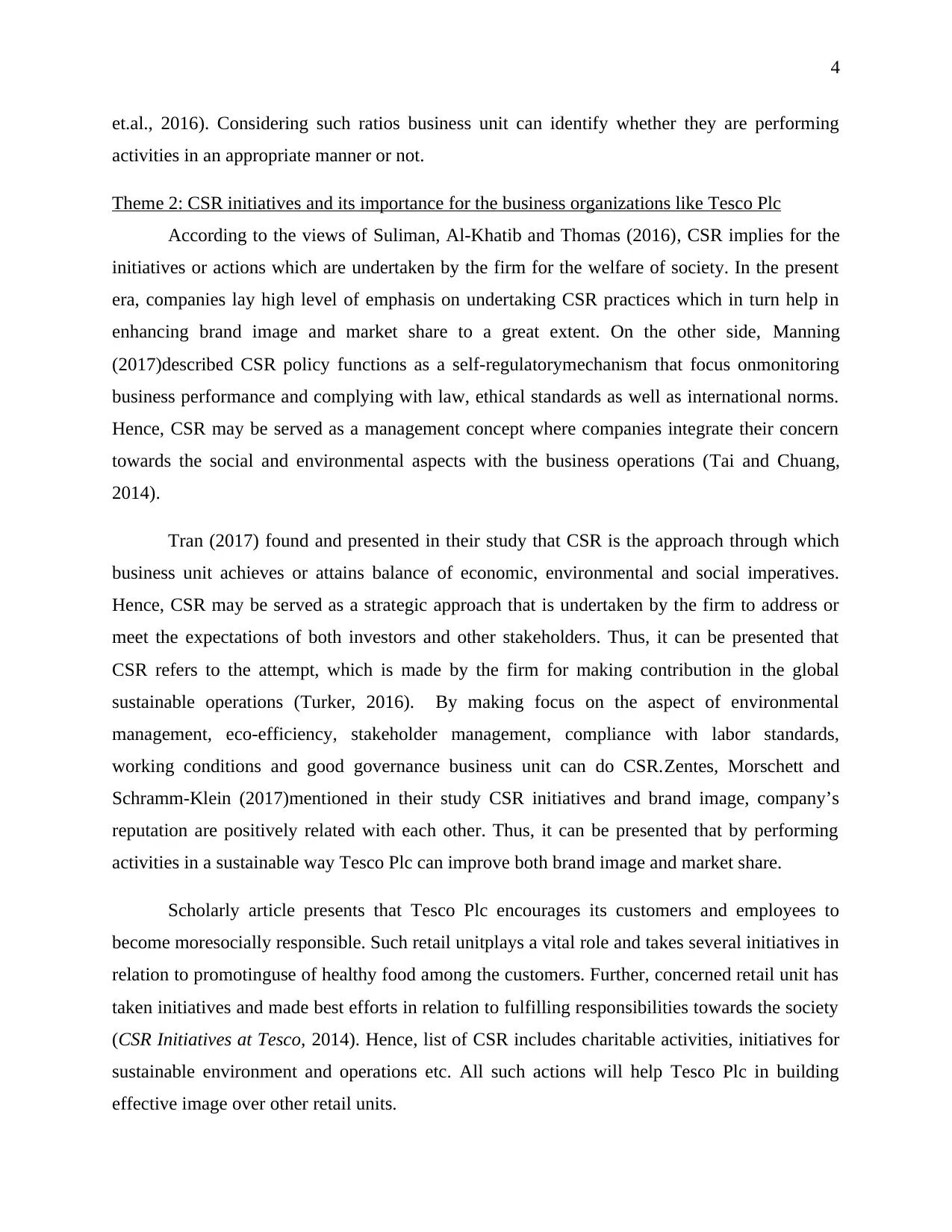
et.al., 2016). Considering such ratios business unit can identify whether they are performing
activities in an appropriate manner or not.
Theme 2: CSR initiatives and its importance for the business organizations like Tesco Plc
According to the views of Suliman, Al-Khatib and Thomas (2016), CSR implies for the
initiatives or actions which are undertaken by the firm for the welfare of society. In the present
era, companies lay high level of emphasis on undertaking CSR practices which in turn help in
enhancing brand image and market share to a great extent. On the other side, Manning
(2017)described CSR policy functions as a self-regulatorymechanism that focus onmonitoring
business performance and complying with law, ethical standards as well as international norms.
Hence, CSR may be served as a management concept where companies integrate their concern
towards the social and environmental aspects with the business operations (Tai and Chuang,
2014).
Tran (2017) found and presented in their study that CSR is the approach through which
business unit achieves or attains balance of economic, environmental and social imperatives.
Hence, CSR may be served as a strategic approach that is undertaken by the firm to address or
meet the expectations of both investors and other stakeholders. Thus, it can be presented that
CSR refers to the attempt, which is made by the firm for making contribution in the global
sustainable operations (Turker, 2016). By making focus on the aspect of environmental
management, eco-efficiency, stakeholder management, compliance with labor standards,
working conditions and good governance business unit can do CSR.Zentes, Morschett and
Schramm-Klein (2017)mentioned in their study CSR initiatives and brand image, company’s
reputation are positively related with each other. Thus, it can be presented that by performing
activities in a sustainable way Tesco Plc can improve both brand image and market share.
Scholarly article presents that Tesco Plc encourages its customers and employees to
become moresocially responsible. Such retail unitplays a vital role and takes several initiatives in
relation to promotinguse of healthy food among the customers. Further, concerned retail unit has
taken initiatives and made best efforts in relation to fulfilling responsibilities towards the society
(CSR Initiatives at Tesco, 2014). Hence, list of CSR includes charitable activities, initiatives for
sustainable environment and operations etc. All such actions will help Tesco Plc in building
effective image over other retail units.
4
activities in an appropriate manner or not.
Theme 2: CSR initiatives and its importance for the business organizations like Tesco Plc
According to the views of Suliman, Al-Khatib and Thomas (2016), CSR implies for the
initiatives or actions which are undertaken by the firm for the welfare of society. In the present
era, companies lay high level of emphasis on undertaking CSR practices which in turn help in
enhancing brand image and market share to a great extent. On the other side, Manning
(2017)described CSR policy functions as a self-regulatorymechanism that focus onmonitoring
business performance and complying with law, ethical standards as well as international norms.
Hence, CSR may be served as a management concept where companies integrate their concern
towards the social and environmental aspects with the business operations (Tai and Chuang,
2014).
Tran (2017) found and presented in their study that CSR is the approach through which
business unit achieves or attains balance of economic, environmental and social imperatives.
Hence, CSR may be served as a strategic approach that is undertaken by the firm to address or
meet the expectations of both investors and other stakeholders. Thus, it can be presented that
CSR refers to the attempt, which is made by the firm for making contribution in the global
sustainable operations (Turker, 2016). By making focus on the aspect of environmental
management, eco-efficiency, stakeholder management, compliance with labor standards,
working conditions and good governance business unit can do CSR.Zentes, Morschett and
Schramm-Klein (2017)mentioned in their study CSR initiatives and brand image, company’s
reputation are positively related with each other. Thus, it can be presented that by performing
activities in a sustainable way Tesco Plc can improve both brand image and market share.
Scholarly article presents that Tesco Plc encourages its customers and employees to
become moresocially responsible. Such retail unitplays a vital role and takes several initiatives in
relation to promotinguse of healthy food among the customers. Further, concerned retail unit has
taken initiatives and made best efforts in relation to fulfilling responsibilities towards the society
(CSR Initiatives at Tesco, 2014). Hence, list of CSR includes charitable activities, initiatives for
sustainable environment and operations etc. All such actions will help Tesco Plc in building
effective image over other retail units.
4
⊘ This is a preview!⊘
Do you want full access?
Subscribe today to unlock all pages.

Trusted by 1+ million students worldwide
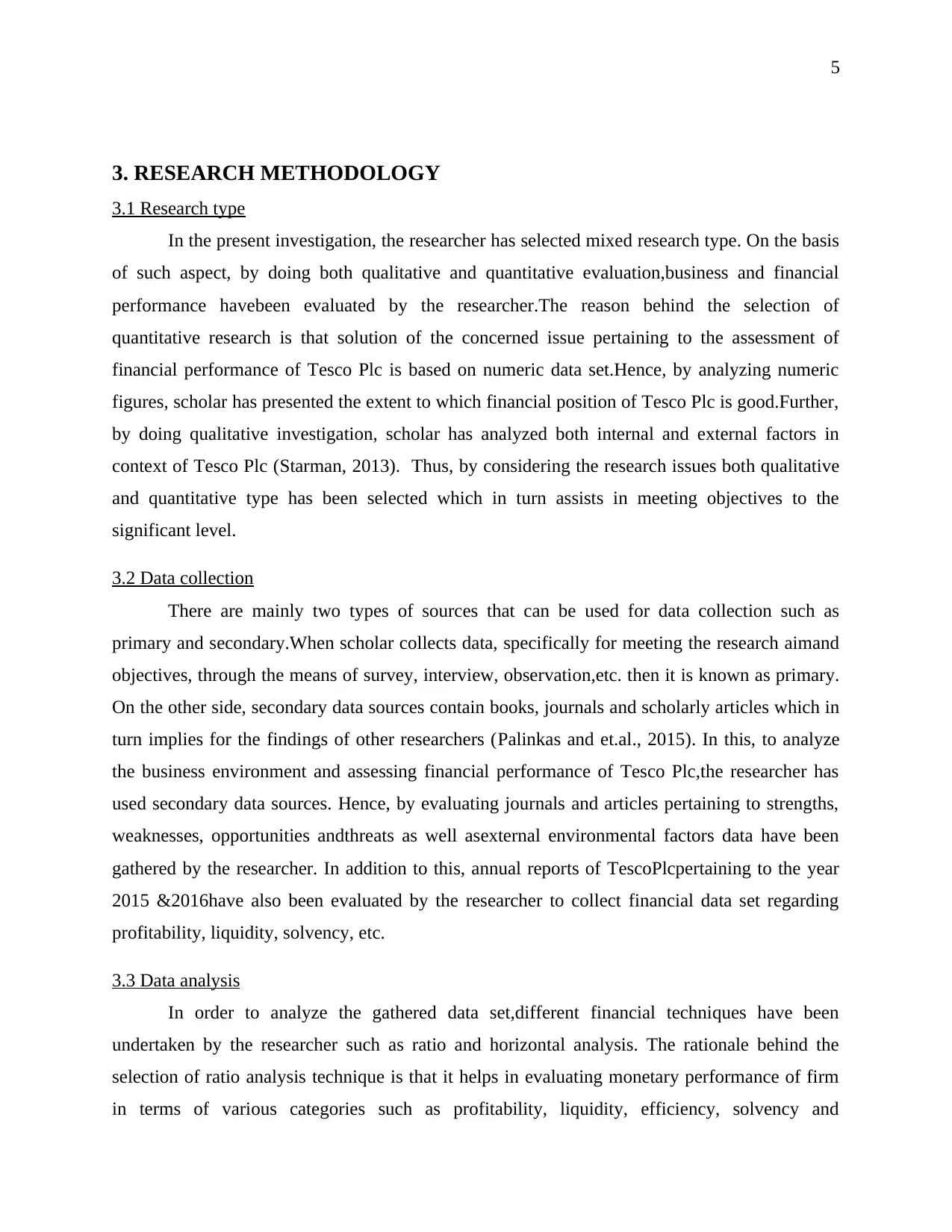
3. RESEARCH METHODOLOGY
3.1 Research type
In the present investigation, the researcher has selected mixed research type. On the basis
of such aspect, by doing both qualitative and quantitative evaluation,business and financial
performance havebeen evaluated by the researcher.The reason behind the selection of
quantitative research is that solution of the concerned issue pertaining to the assessment of
financial performance of Tesco Plc is based on numeric data set.Hence, by analyzing numeric
figures, scholar has presented the extent to which financial position of Tesco Plc is good.Further,
by doing qualitative investigation, scholar has analyzed both internal and external factors in
context of Tesco Plc (Starman, 2013). Thus, by considering the research issues both qualitative
and quantitative type has been selected which in turn assists in meeting objectives to the
significant level.
3.2 Data collection
There are mainly two types of sources that can be used for data collection such as
primary and secondary.When scholar collects data, specifically for meeting the research aimand
objectives, through the means of survey, interview, observation,etc. then it is known as primary.
On the other side, secondary data sources contain books, journals and scholarly articles which in
turn implies for the findings of other researchers (Palinkas and et.al., 2015). In this, to analyze
the business environment and assessing financial performance of Tesco Plc,the researcher has
used secondary data sources. Hence, by evaluating journals and articles pertaining to strengths,
weaknesses, opportunities andthreats as well asexternal environmental factors data have been
gathered by the researcher. In addition to this, annual reports of TescoPlcpertaining to the year
2015 &2016have also been evaluated by the researcher to collect financial data set regarding
profitability, liquidity, solvency, etc.
3.3 Data analysis
In order to analyze the gathered data set,different financial techniques have been
undertaken by the researcher such as ratio and horizontal analysis. The rationale behind the
selection of ratio analysis technique is that it helps in evaluating monetary performance of firm
in terms of various categories such as profitability, liquidity, efficiency, solvency and
5
3.1 Research type
In the present investigation, the researcher has selected mixed research type. On the basis
of such aspect, by doing both qualitative and quantitative evaluation,business and financial
performance havebeen evaluated by the researcher.The reason behind the selection of
quantitative research is that solution of the concerned issue pertaining to the assessment of
financial performance of Tesco Plc is based on numeric data set.Hence, by analyzing numeric
figures, scholar has presented the extent to which financial position of Tesco Plc is good.Further,
by doing qualitative investigation, scholar has analyzed both internal and external factors in
context of Tesco Plc (Starman, 2013). Thus, by considering the research issues both qualitative
and quantitative type has been selected which in turn assists in meeting objectives to the
significant level.
3.2 Data collection
There are mainly two types of sources that can be used for data collection such as
primary and secondary.When scholar collects data, specifically for meeting the research aimand
objectives, through the means of survey, interview, observation,etc. then it is known as primary.
On the other side, secondary data sources contain books, journals and scholarly articles which in
turn implies for the findings of other researchers (Palinkas and et.al., 2015). In this, to analyze
the business environment and assessing financial performance of Tesco Plc,the researcher has
used secondary data sources. Hence, by evaluating journals and articles pertaining to strengths,
weaknesses, opportunities andthreats as well asexternal environmental factors data have been
gathered by the researcher. In addition to this, annual reports of TescoPlcpertaining to the year
2015 &2016have also been evaluated by the researcher to collect financial data set regarding
profitability, liquidity, solvency, etc.
3.3 Data analysis
In order to analyze the gathered data set,different financial techniques have been
undertaken by the researcher such as ratio and horizontal analysis. The rationale behind the
selection of ratio analysis technique is that it helps in evaluating monetary performance of firm
in terms of various categories such as profitability, liquidity, efficiency, solvency and
5
Paraphrase This Document
Need a fresh take? Get an instant paraphrase of this document with our AI Paraphraser
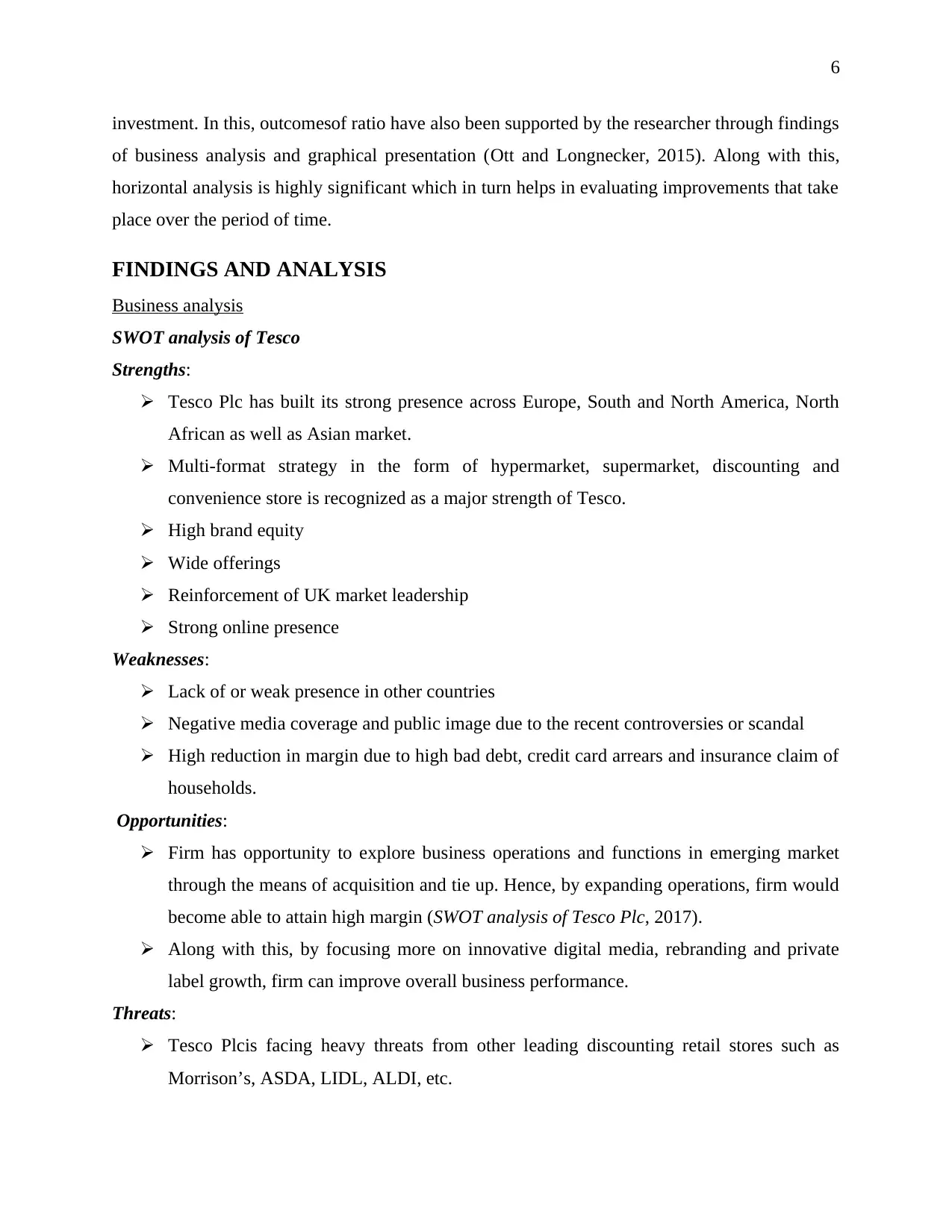
investment. In this, outcomesof ratio have also been supported by the researcher through findings
of business analysis and graphical presentation (Ott and Longnecker, 2015). Along with this,
horizontal analysis is highly significant which in turn helps in evaluating improvements that take
place over the period of time.
FINDINGS AND ANALYSIS
Business analysis
SWOT analysis of Tesco
Strengths:
Tesco Plc has built its strong presence across Europe, South and North America, North
African as well as Asian market.
Multi-format strategy in the form of hypermarket, supermarket, discounting and
convenience store is recognized as a major strength of Tesco.
High brand equity
Wide offerings
Reinforcement of UK market leadership
Strong online presence
Weaknesses:
Lack of or weak presence in other countries
Negative media coverage and public image due to the recent controversies or scandal
High reduction in margin due to high bad debt, credit card arrears and insurance claim of
households.
Opportunities:
Firm has opportunity to explore business operations and functions in emerging market
through the means of acquisition and tie up. Hence, by expanding operations, firm would
become able to attain high margin (SWOT analysis of Tesco Plc, 2017).
Along with this, by focusing more on innovative digital media, rebranding and private
label growth, firm can improve overall business performance.
Threats:
Tesco Plcis facing heavy threats from other leading discounting retail stores such as
Morrison’s, ASDA, LIDL, ALDI, etc.
6
of business analysis and graphical presentation (Ott and Longnecker, 2015). Along with this,
horizontal analysis is highly significant which in turn helps in evaluating improvements that take
place over the period of time.
FINDINGS AND ANALYSIS
Business analysis
SWOT analysis of Tesco
Strengths:
Tesco Plc has built its strong presence across Europe, South and North America, North
African as well as Asian market.
Multi-format strategy in the form of hypermarket, supermarket, discounting and
convenience store is recognized as a major strength of Tesco.
High brand equity
Wide offerings
Reinforcement of UK market leadership
Strong online presence
Weaknesses:
Lack of or weak presence in other countries
Negative media coverage and public image due to the recent controversies or scandal
High reduction in margin due to high bad debt, credit card arrears and insurance claim of
households.
Opportunities:
Firm has opportunity to explore business operations and functions in emerging market
through the means of acquisition and tie up. Hence, by expanding operations, firm would
become able to attain high margin (SWOT analysis of Tesco Plc, 2017).
Along with this, by focusing more on innovative digital media, rebranding and private
label growth, firm can improve overall business performance.
Threats:
Tesco Plcis facing heavy threats from other leading discounting retail stores such as
Morrison’s, ASDA, LIDL, ALDI, etc.
6
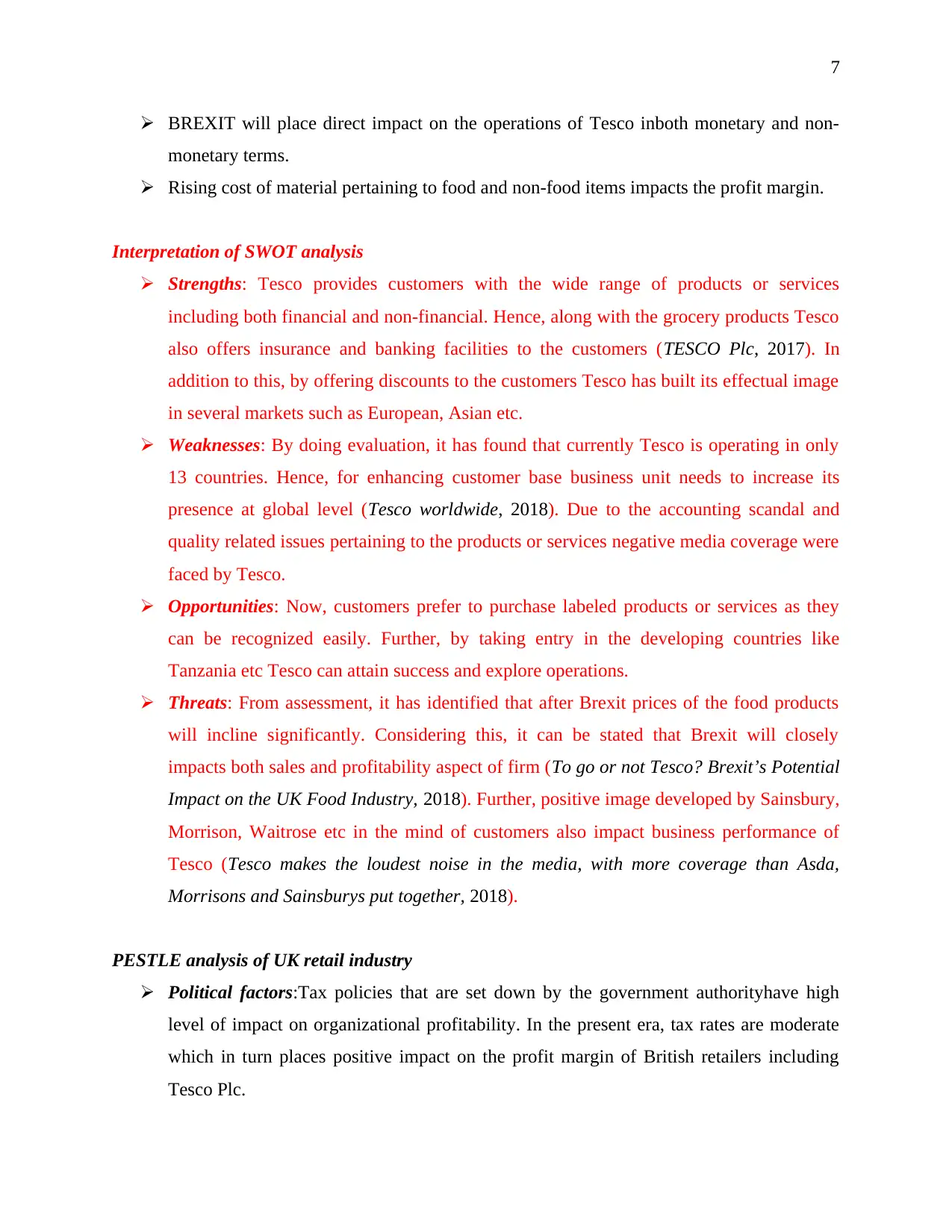
BREXIT will place direct impact on the operations of Tesco inboth monetary and non-
monetary terms.
Rising cost of material pertaining to food and non-food items impacts the profit margin.
Interpretation of SWOT analysis
Strengths: Tesco provides customers with the wide range of products or services
including both financial and non-financial. Hence, along with the grocery products Tesco
also offers insurance and banking facilities to the customers (TESCO Plc, 2017). In
addition to this, by offering discounts to the customers Tesco has built its effectual image
in several markets such as European, Asian etc.
Weaknesses: By doing evaluation, it has found that currently Tesco is operating in only
13 countries. Hence, for enhancing customer base business unit needs to increase its
presence at global level (Tesco worldwide, 2018). Due to the accounting scandal and
quality related issues pertaining to the products or services negative media coverage were
faced by Tesco.
Opportunities: Now, customers prefer to purchase labeled products or services as they
can be recognized easily. Further, by taking entry in the developing countries like
Tanzania etc Tesco can attain success and explore operations.
Threats: From assessment, it has identified that after Brexit prices of the food products
will incline significantly. Considering this, it can be stated that Brexit will closely
impacts both sales and profitability aspect of firm (To go or not Tesco? Brexit’s Potential
Impact on the UK Food Industry, 2018). Further, positive image developed by Sainsbury,
Morrison, Waitrose etc in the mind of customers also impact business performance of
Tesco (Tesco makes the loudest noise in the media, with more coverage than Asda,
Morrisons and Sainsburys put together, 2018).
PESTLE analysis of UK retail industry
Political factors:Tax policies that are set down by the government authorityhave high
level of impact on organizational profitability. In the present era, tax rates are moderate
which in turn places positive impact on the profit margin of British retailers including
Tesco Plc.
7
monetary terms.
Rising cost of material pertaining to food and non-food items impacts the profit margin.
Interpretation of SWOT analysis
Strengths: Tesco provides customers with the wide range of products or services
including both financial and non-financial. Hence, along with the grocery products Tesco
also offers insurance and banking facilities to the customers (TESCO Plc, 2017). In
addition to this, by offering discounts to the customers Tesco has built its effectual image
in several markets such as European, Asian etc.
Weaknesses: By doing evaluation, it has found that currently Tesco is operating in only
13 countries. Hence, for enhancing customer base business unit needs to increase its
presence at global level (Tesco worldwide, 2018). Due to the accounting scandal and
quality related issues pertaining to the products or services negative media coverage were
faced by Tesco.
Opportunities: Now, customers prefer to purchase labeled products or services as they
can be recognized easily. Further, by taking entry in the developing countries like
Tanzania etc Tesco can attain success and explore operations.
Threats: From assessment, it has identified that after Brexit prices of the food products
will incline significantly. Considering this, it can be stated that Brexit will closely
impacts both sales and profitability aspect of firm (To go or not Tesco? Brexit’s Potential
Impact on the UK Food Industry, 2018). Further, positive image developed by Sainsbury,
Morrison, Waitrose etc in the mind of customers also impact business performance of
Tesco (Tesco makes the loudest noise in the media, with more coverage than Asda,
Morrisons and Sainsburys put together, 2018).
PESTLE analysis of UK retail industry
Political factors:Tax policies that are set down by the government authorityhave high
level of impact on organizational profitability. In the present era, tax rates are moderate
which in turn places positive impact on the profit margin of British retailers including
Tesco Plc.
7
⊘ This is a preview!⊘
Do you want full access?
Subscribe today to unlock all pages.

Trusted by 1+ million students worldwide
1 out of 31
Related Documents
Your All-in-One AI-Powered Toolkit for Academic Success.
+13062052269
info@desklib.com
Available 24*7 on WhatsApp / Email
![[object Object]](/_next/static/media/star-bottom.7253800d.svg)
Unlock your academic potential
Copyright © 2020–2025 A2Z Services. All Rights Reserved. Developed and managed by ZUCOL.




